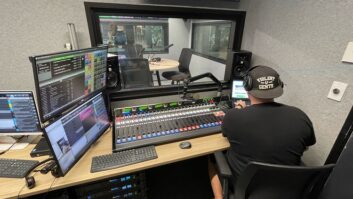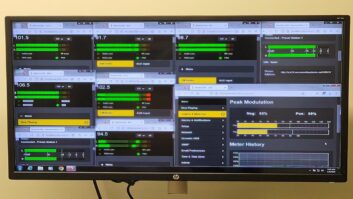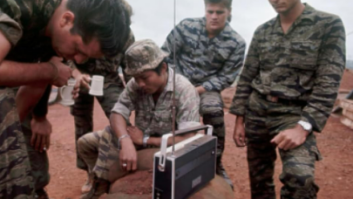ANTWERP, Belgium — At the end of last year, Nostalgie launched its new transmitter park, which many consider to be one of the most modern technical broadcast operations in Belgium. The national commercial network renovated its complete transmission chain and 28 transmitter sites around the five Flemish provinces of Antwerp, East-Flanders, West-Flanders, Limburg and Flemish Brabant.


Nostalgie’s Operations Manager Bas Boone works in the central machine room, which was completely upgraded with five Omnia.11 processors and 28 Telos Z/IP One IP audio codecs.
Credit all: © Mmpress
FULL CONTROL
In 2007, Nostalgie started using a leased transmitter network — the nine-year contract, which comprised installation, operation and maintenance, concluded at the end of 2016.
“We felt the time was right to evaluate our whole broadcast transmission system and see where we could improve listening comfort,” said Bas Boone, operations manager with Nostalgie.
“Instead of renewing the contract, we decided to step away from leasing and take on the network upgrade ourselves — today the entire transmitter park (antenna sites, transmitters, filters and connectivity) is owned by Nostalgie.”
The renewal of the station’s antenna sites represents a substantial investment, but with the current FM licences being extended to 2022, the Nostalgie management judged it worthwhile to write off the expenditure in five years.
The big advantage of owning the broadcast chain, according to Boone, is that Nostalgie is in total control of the antenna pattern of each site, allowing for full optimization within the station’s network and boundaries of the broadcast licence.

“Each antenna has a dedicated pattern, which corresponds to the license, stating frequency, output power and radius of the antenna,” said Boone. “Previously, with leased antenna locations, we had to share a mast with other stations, often resulting in compromises, such as weaker output power. Shared antennas are far from optimal and failed to meet our expectations in terms of quality.”
He added that in order to achieve the best results in accordance with license requirements, some of the antenna masts had to be relocated. For instance, in West-Flanders, the broadcaster moved the antenna from the shared Norkring mast in the rural village of Egem to a site nearby the city of Roeselare, resulting in better coverage. Nostalgie also relocated its antenna at the Norkring VRT mast in Schoten, near Antwerp, to a site near the Albert canal. The move added 100 kW ERP, doubling the initial output power.

LOGISTICS
“The big challenge was to upgrade and/or relocate the 28 Nostalgie transmitter sites, while the existing infrastructure had to remain operational,” continued Boone. “Both in terms of logistics (providing mains, facilities such as shelter and insulation and connectivity) and administration, because we had to apply for a broadcast licence renewal for each antenna. The moment you change the antenna’s position, height, cabling or location, it is subject to a coordination approval by the The Flemish Media Regulatory body, Vlaamse Regulator voor de Media (VRM). All this while the existing equipment remained operational, until the full upgrade was finalized and the new gear was put in the racks without any interruption in the broadcast.”
System integrator and equipment supplier TVV Sound took on the technical side of the transmission upgrade. The firm built a completely new setup alongside the existing infrastructure. The new equipment consists of five Omnia.11 processors at the Nostalgie headquarters and an Omnia One processor at each of the 28 sites, plus a total of 56 Telos Z/IP One audio IP codecs (28 at the headquarters and one at each site), and a DEVA SmartGen 6.0 RDS encoder at each of the 28 sites. The transition took five months.

A closeup of the Aldena antenna situated on the 17th floor of a rice silo in Merksem.
Nostalgie’s on-air signal is routed, through a central DHD matrix, to the main Omnia.11 processors in the central machine room, using an AES digital audio connection. “The Omnia.11 is undoubtedly one of the most powerful processors today, providing maximum output power to the transmitters,” said Edo Dijkstra of TVV Sound. “We used Livewire to connect the Omnia processors to the Telos codecs — in the future we plan to connect the full Nostalgie studio landscape (two on-air studios and two voice booths) via Livewire using AoIP.”
With Nostalgie holding a national licence, but offering regional advertising, each of the five provinces in Flanders is using a dedicated Omnia.11 processor. “For the connection with the antenna sites, we designed a complete permanent glass fiber AoIP VPN network with telecom provider Telenet,” said Dijkstra. “We wanted to keep the connectivity simple, linking the engine room with the 28 sites throughout the country.”
FULL REDUNDANCY
The broadcast transmission also includes multiple layers of redundancy. A first backup system constantly monitors the quality and continuity of the signal and automatically switches to 4G, should any quality loss occur on the cable connection — the 4G connection takes over automatically and switches off when the cable connection is restored. “In addition, we have also integrated a local audio backup. Each transmitter site is equipped with an Omnia One audio processor with an incorporated audio SD card. When a specific link goes down, the Omnia One streams audio content to the transmitter ensuring Nostalgie’s signal,” added Dijkstra.
A DEVA DB44 radio monitoring receiver was put in place at each site to monitor potential issues, such as power loss of each of the 28 transmitters. The DEVA DB44 automatically generates alert messages either via email or SMS.
In addition, every piece of equipment on each site has an individual SNMP monitoring server, giving alert and feedback to the central machine room in Antwerp in case of technical problems like overheating or antenna failures.
The Nostalgie transmitter park is equipped with a combination of Aldena FM antennas with a Rohde & Schwarz THR9 15 kW water-cooled transmitter for the high-power frequency in Antwerp, 12 medium-power Neetra DATx transmitters and 15 BW Broadcast TX1500 V2 transmitters for the low-power sites.

A photo of the new 15 kW Aldena antenna sited on the Bosto Tower near the Albert Canal in Antwerp.
On Nov 1, Boone turned on the new transmitter park, he says audience response to the network, which according to the Centre for Information on the Media – Wave 3 ratings results published on Feb 9 attracts 5.7 percent of the market, has been very positive.
“Our frequencies remain unchanged but listening comfort has drastically increased. At present, we cannot measure the impact of the new air chain in terms of audience ratings — I’m well aware that better signal reception does not immediately attract thousands of additional listeners, but I’m convinced that it will help listeners discover Nostalgie. It’s a slow process,” he added.
“We are convinced that investing in FM is the shortest path to higher ratings and listeners satisfaction,” stated Dirk Guldemont, managing director Nostalgie Vlaanderen. “The political decision to invest in and rollout DAB+ has been taken, and we will follow that path with an open mind, as one of the multiple ways of offering our programming to our audience. The current DAB+ reach does not offer a viable alternative to FM or even webcasting, but as a national broadcaster it is our role to explore and try to develop new markets and technologies.”
Marc Maes reports on the industry for Radio World from Antwerp, Belgium.












